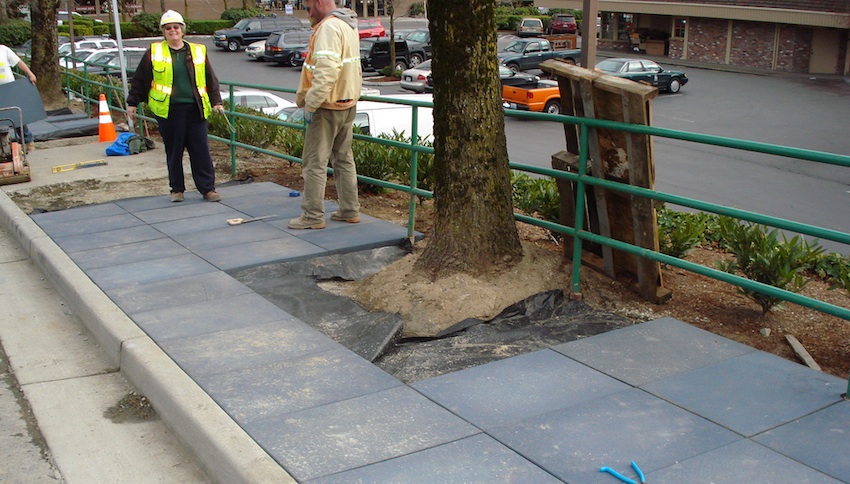Should Boston Have Rubber Sidewalks?

Photo via Flickr.com
If you drive up and down some of Boston’s streets, you may notice that a lot of the sidewalks are cracking, caving in, or creating mini-obstacles that impede pedestrians, says City Councilor Rob Consalvo.
“We have these huge trees in Mattapan and West Roxbury, that have huge root structures. I can name 100 locations in my district alone where [the roots] push up the sidewalk panels, and then people complain that they can’t bypass the area. It becomes especially difficult for people in wheelchairs, or with strollers,” he said.
Not to mention that fixing the problem takes a lot of work, concrete, and a mixture of government resources and tax-payer dollars. First, a contractor has to be hired to break up the concrete with a jackhammer. This part of the process has to be done in conjunction with the city’s Parks Department, which shaves back the tree’s roots since they can’t take down a living tree. Then, once trimmed back, the workers must pour additional cement back over the roots, “only to have the very same tree have the roots pushed up again” a few years later, says Consalvo.
In order to save the city some money, Consalvo, a mayoral candidate, says that if elected, he would propose Boston adapt the rubber-cement sidewalk model in use by more than 60 cities around the world. “I say we move into this new technology—and it’s a fun, creative low-tech meets high-tech idea,” he says.
Consalvo first proposed rubber sidewalks back in 2006—not long after they were put in place in Washington, D.C.—but getting official approval stalled after what he called a productive public hearing took place. On Friday, Consalvo posted a Buzzfeed-style listicle on his campaign website with the top 12 reasons he believes Boston would benefit from the rubber walkways, bringing the idea back to the surface—and calling it “awesome.”
Topping the list, Consalvo claims the alternative material “promotes the health and stability of urban trees by letting water seep into the seams between the panels.” He also wrote that the rubber panels stretch to accommodate growing tree roots, keeping them from breaking through sidewalks, and accompanied the entire post with photos showing the difference between conventional concrete, and the urban-renewal approach. “I know people will say it’s not a number one issue, but it fits in with the quality of life issues, and my city services platform [for my mayoral campaign],” he says.
Consalvo points out that the slabs, which are used in Denver, Santa Monica, California, and Montgomery, Ala., are made from recycled car tires and are molded in to one-inch-thick squares that fit together like a puzzle piece. Their grey color mimics the look of a conventional sidewalk, however, they’re softer, which is another point added to his online list.
The mayoral candidate isn’t trying to turn the entire city into a rubberized walkway, and would only be interested in laying down the squares in certain neighborhoods, he says—or where metal grates currently cover trees in the Downtown area. “Where the city is more dense, they put a metal grate around trees, but they have holes, and they are rough and brake, and sometimes crack. Women in high heels have issues with them, too.”
In Australia, the sidewalks were installed in front of bars to keep intoxicated patrons from hurting themselves if they tripped or stumbled. One company that produces the slabs also boasts that the rubber pathways make shoveling snow nearly effortless, something that could come in handy during Boston’s heavy winters when the city gets walloped by storms.
While some residents in Washington, D.C., have complained about the approach, likening it to a playground or saying it doesn’t “look right,” Consalvo is still putting it out there to start a conversation. “It’s a fascinating solution to the problem that we should be doing,” he says.


